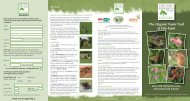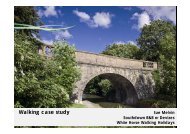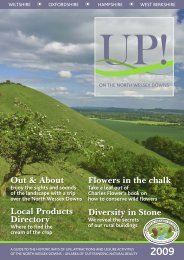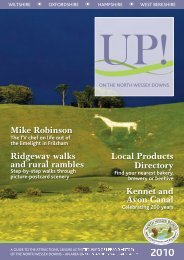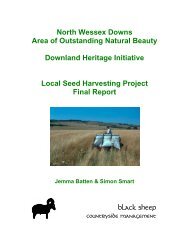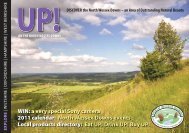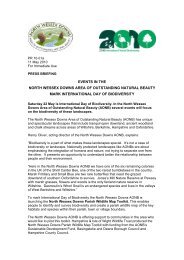You can download a copy here - North Wessex Downs Area of ...
You can download a copy here - North Wessex Downs Area of ...
You can download a copy here - North Wessex Downs Area of ...
- No tags were found...
You also want an ePaper? Increase the reach of your titles
YUMPU automatically turns print PDFs into web optimized ePapers that Google loves.
WELCOME<strong>North</strong>to the<strong>Wessex</strong> <strong>Downs</strong><strong>Area</strong> <strong>of</strong> Outstanding Natural Beauty> W<strong>here</strong> to go> What to see> Map <strong>of</strong> the area© Jon CruiseNORTH WESSEXDOWNSOne <strong>of</strong> theAONB Family
A truly special placeFrom remote, rolling downlandto charming market townsand picture postcard villages,the <strong>North</strong> <strong>Wessex</strong> <strong>Downs</strong>are a truly special place.Undoubtedly one <strong>of</strong> Britain’smost beautiful landscapes, the<strong>Downs</strong> are somew<strong>here</strong> to betreasured and protected.© Stan Green © Andrew PerrottIf you love all that is best in theBritish countryside, you <strong>can</strong>not fail toappreciate this <strong>of</strong>ten unheralded patchstraddling four counties. It is an areaunited by one single factor – chalk. Thegeology gives this area its wide opendownland topped by rampant whitehorses, dramatic scarp slopes, majesti<strong>can</strong>cient woodland and sheltered valleyswith sparkling rivers and streams.But amidst the peace t<strong>here</strong> is endlessfascination because the <strong>North</strong> <strong>Wessex</strong><strong>Downs</strong> are also packed with wildlife,history, romance and bustling business.Take a closerlook. <strong>You</strong> won’tbe disappointed.“Somew<strong>here</strong> tobe explored,treasured andprotected“
“So preciousAn <strong>Area</strong> <strong>of</strong> Outstanding Natural Beauty (AONB) is a preciouslandscape whose distinctive character and natural beauty arerecognised as so outstanding that it should be protected for thenation. The <strong>North</strong> <strong>Wessex</strong> <strong>Downs</strong> make up the third largest <strong>of</strong>Britain’s 46 AONBs, covering an area <strong>of</strong> 668 square miles (1,075square kilometres) and taking in 173 parishes including the markettowns <strong>of</strong> Hungerford and Marlborough.“ A living,workinglandscapeAs the celebrated poet Edward Thomaswrote: “This is pure downland, thebreasted hills curved as if under theinfluence <strong>of</strong> a great melody. It isbeautiful, quiet and unrenowned anda most visibly ancient landscape.”AONBs are not, however, just aboutbeing beautiful. They are living, workinglandscapes much loved by residents andvisitors alike.Conserving and enhancing the naturalbeauty <strong>of</strong> the <strong>North</strong> <strong>Wessex</strong> <strong>Downs</strong>is the responsibility <strong>of</strong> nine localauthorities in Berkshire, Hampshire,Oxfordshire and Wiltshire. They cometogether with community, farming,conservation, tourism and heritagerepresentatives to make up thegoverning Council <strong>of</strong> Partners, which issupported by a small pr<strong>of</strong>essional team.The staff produce a management planfor the area and work with all interestedparties to make it happen.© Blue Sky Images
Digging downScratch the surface in the <strong>North</strong> <strong>Wessex</strong> <strong>Downs</strong> and you findwhat really makes it tick – chalk. The area lies at the heart <strong>of</strong> thechalk band that stretches across southern England and was onceunder a warm sea. The geology is based on tiny creatures thatlived in the sea around 65 million years ago and are the source <strong>of</strong>today’s s<strong>of</strong>t rock.The fact that rain runs so readilythrough the chalk creates dryvalleys with streams and seasonalwinterbournes that carry crystal-clearfiltered water from hillside springs at aconstant temperature. Chalk streamsare internationally rare habitatsthat support some <strong>of</strong> the UK’s mostthreatened and fragile plants andanimals.The geology is responsible not just forthe rolling and sometimes dramaticcontours <strong>of</strong> the landscape but forsweeps <strong>of</strong> chalk grassland that haven’tbeen disturbed in centuries. Alongthe northern edge <strong>of</strong> the area runsone <strong>of</strong> Britain’s most ancient roads,the Ridgeway, the ancient chalk routeused by prehistoric man. The exposeddownland with its lack <strong>of</strong> waterencouraged the local population tosettle in the few river valleys w<strong>here</strong> theycleared wildwood for arable crops andestablished pasture. W<strong>here</strong> you havechalk, you also <strong>of</strong>ten have flints thatcontribute to the character <strong>of</strong> the area’spicturesque villages.The <strong>North</strong> <strong>Wessex</strong> <strong>Downs</strong> have a richheritage – now<strong>here</strong> more so than atthe world heritage site <strong>of</strong> Avebury.Built and altered over many centuriesfrom around 2600 BC to 2200 BC, itsthree great stone circles enclosed bya massive bank and ditch made it one<strong>of</strong> the principal ceremonial sites <strong>of</strong>Neolithic Britain. Nearby is Silbury Hill,the motive for which remains one <strong>of</strong>the great unsolved mysteries. T<strong>here</strong>are some 20 Neolithic barrows nearby.Other historic sites include Iron Ageenclosures and hillforts at Ladle andBeacon Hills in north Hampshire and atBarbury Castle in Wiltshire.“Silbury Hill,one <strong>of</strong> thegreat unsolvedmysteries© Blue Sky Images
Simply wildThe <strong>North</strong> <strong>Wessex</strong> <strong>Downs</strong> <strong>of</strong>fer wildlife a diverse range <strong>of</strong> specialhabitats. Not least amongst them is the chalk grassland on thin,well-drained soils that are low in nutrients. Traditionally grazedby sheep and rabbits, the characteristically springy turf is a richhabitat that is teeming with farmland birds, chalk-loving flowersand rare butterflies. Wild flowers that thrive include the nectarrichscabious, early gentian, birdsfoot trefoil, pyramidal orchidand hairy violets. They in turn attract insects and you could wellbe lucky enough to see rare butterflies like the Adonis blue andsilver spotted skipper.Listen out for the ‘peewit’ call <strong>of</strong> thelapwing or the distinctive chirruping <strong>of</strong>the skylark. The rare stone curlew withits long yellow legs and round yelloweyes is a summer visitor. The <strong>North</strong><strong>Wessex</strong> <strong>Downs</strong> Farmland Bird Initiativehelps local farmers to protect a range <strong>of</strong>rare birds.“Listen out forlapwings andskylarks“T<strong>here</strong> are ancient heathlands atBucklebury and Inkpen, veteran treesat Ashampstead and Savernake, andbluebells in pr<strong>of</strong>usion at West Woodsnear Marlborough. The Pewsey <strong>Downs</strong>National Nature Reserve is one <strong>of</strong> thefinest examples <strong>of</strong> chalk downland insouthern England. Small wonder the<strong>North</strong> <strong>Wessex</strong> <strong>Downs</strong> have no fewerthan 66 Sites <strong>of</strong> Special ScientificInterest (SSSIs).© Barry Stalker© Blue Sky Images
Famous placesThe simple beauty <strong>of</strong> the <strong>North</strong> <strong>Wessex</strong> <strong>Downs</strong> has capturedthe imaginations <strong>of</strong> writers and TV/film producers alike.Samuel Pepys, Richard Jefferies, Edward Thomas and JohnBetjeman all wrote about the area. The National Trust’sBasildon Park near Pangbourne with its impressive Georgianmansion was the setting for the 2005 feature film <strong>of</strong> JaneAusten’s Pride and Prejudice.More recently, Highclere Castle hasachieved national fame as the locationfor the hugely popular ITV seriesDownton Abbey. Avebury Manorcame to fame in 2011 as part <strong>of</strong> a TVtransformation which makes it and itsgardens well worth seeing as part <strong>of</strong>a visit to the mystical stone circle. TheNational Trust cares for Ashdown Housenear Lambourn with its unusual dolls’house appearance and for Sir StanleySpencer’s striking pictures <strong>of</strong> First WorldWar Salonika filling a small chapel atBurghclere.All venues quoted <strong>here</strong> are open to theirown timetables and should be checkedbefore making visits.“A most visiblyancientlandscapeEdward Thomas 1878-1917“© Lord Carnarvon © Peter Orr
Getting <strong>here</strong>Stand on the top <strong>of</strong> the <strong>Downs</strong> and you could be many miles fromanyw<strong>here</strong>. But the reality is that, given their central location, the<strong>North</strong> <strong>Wessex</strong> <strong>Downs</strong> are actually very accessible. While t<strong>here</strong>are only two modest-sized market towns, the <strong>Downs</strong> have muchlarger towns like Reading, Swindon, Newbury, Basingstoke,Andover, Devizes and Didcot at their gateways, with no fewerthan eight railway stations in the area and 12 others nearby.Public transport is an environmentallyfriendlyand cost-effective option.The area benefits from a network <strong>of</strong>innovative bus services which will takeyou out into the more remote parts <strong>of</strong>the area. <strong>You</strong> <strong>can</strong> “dial-on-demand”to book some services. For moreinformation on getting around the<strong>North</strong> <strong>Wessex</strong> <strong>Downs</strong> by bus, coach andtrain visit www.traveline.com. T<strong>here</strong>are over 900 miles <strong>of</strong> footpaths - werecommend some excellent walks onour website.The amazing scenery is also anargument for taking to the saddle, withplenty <strong>of</strong> opportunities whether youare a beginner or an owner wantingsomew<strong>here</strong> to stay with stables. Or howabout touring the pr<strong>of</strong>usion <strong>of</strong> quietcountry lanes and byways by bike? TheNational Cycling Network route 4 is one<strong>of</strong> the most pleasant ways to explorethe <strong>North</strong> <strong>Wessex</strong> <strong>Downs</strong>, following theKennet & Avon Canal out <strong>of</strong> Readingto Newbury, Hungerford, Bedwyn andPewsey to Devizes.Canal holidays are another relaxingway <strong>of</strong> enjoying the area. The maintowns all have companies <strong>of</strong>feringnarrow boat hire.© Nick Tipper
Take a wanderThe <strong>North</strong> <strong>Wessex</strong> <strong>Downs</strong> are well worth a wander, whether thatmeans the great outdoors or some more specific attraction. Thebig open skies with their panoramic views make the countrysideideal for bird watching, cycling, walking, fishing, riding – andstar-gazing on clear nights.The Lambourn valley is one <strong>of</strong> Britain’smost prolific centres for trainingracehorses, so you may well comeacross some very expensive horseflesh in your travels – or watch themcompete at Newbury Racecourse. <strong>You</strong><strong>can</strong> also fish on the Kennet, Lambourn,Pang and Avon. If you want to set yourpulse racing a little faster, you could tryparagliding, kiteboarding and <strong>can</strong>oeingor take to the skies in a hot air balloon.Picturesque downland villages eachhave their own attractions which <strong>of</strong>teninclude a fine church and sometimesa thatched country pub. Towns likeHungerford (famous for its antiques)and Marlborough with its impressiveGeorgian High Street and annual jazzfestival have much to <strong>of</strong>fer, especiallyon market days. Savernake Forest isonly just outside Marlborough and isgreat for walks and picnics. The Kennet& Avon Canal meanders all the waythrough the area. It’s worth takingtime out from your stroll to admirethe steam-powered engineering atthe Cr<strong>of</strong>ton Pumping Station which isthe highest point on the <strong>can</strong>al and liftswater 400 feet (122m) from the river.“Big open skiesand panoramicviews<strong>North</strong> <strong>Wessex</strong> <strong>Downs</strong><strong>Area</strong> <strong>of</strong> Outstanding Natural BeautyUnits 3-4, Denford Manor, Lower Denford,Hungerford RG17 0UNtel: 01488 685440web: www.northwessexdowns.org.ukemail: info@northwessexdowns.org.ukPrinted on FSC approved stock using recycled contentDesign/production: www.publicityproject.co.ukProduced on behalf <strong>of</strong> the Council <strong>of</strong> Partners“




